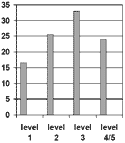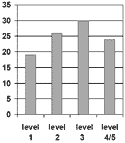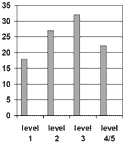Prose Literacy

- 43% of Canadians are at first two levels of IALS
- 33% of Canadians are at level 3
- 24% of Canadians are at level 4/5
|
- This graph refers to prose literacy only.
- This category addresses the knowledge and skills needed to
understand and use information from texts including editorials,
news stories, poems and fiction.
- Note that 24% of Canadians are at level 4/5 and that over 70%of
Canadians are below level 4/5.
- 43% of Canadians are at levels 1 and 2.
|
Document Use

- 46% of Canadians are at the first two levels of IALS
- 30% of Canadians are at level 3
- 24% of Canadians are at level 4/5
|
- This slide refers to document literacy where tasks included
locating and using information in various formats: forms, schedules,
maps, graphics.
- The ability to search documents for specific information is
an important document literacy skill in today’s workplaces.
|
Quantitative Literacy

- 46% of Canadians are at the first two levels
- 32% of Canadians are at level 3
- 22% of Canadians are at level 4/5
|
- Quantitative literacy refers to arithmetic operations where
the numbers must be located in and extracted from different types
of documents.
- It has been found that individuals may be able to perform numeracy
operations when the numbers and operations required are explicit.
- However, when these numbers are embedded in text, the task
becomes more difficult, especially if there is information present
that is similar but irrelevant to the information needed to complete
the numeracy task.
|
|


